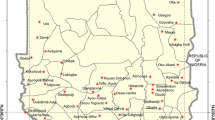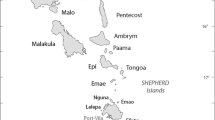Abstract
Cassava (Manihot esculenta Crantz) is one of the most produced and consumed food crops in the Republic of Congo. To assess the diversity and understand the traditional management of its cultivars in the department of Bouenza, twenty-one villages randomly selected from nine ethnic zones were surveyed using participatory rural appraisal. Altogether, 86 land races cultivars were recorded and further grouped into 36 types based on their agronomic and culinary characteristics. The number of cultivars accessed varied from 6 to 21 per village (13 on average) and from 1 to 11 (4 on average) per household. Their distribution and extent analysis revealed some worrying rates of cultivar loss in the range of 7.41–66.67% (32.06% on average) per village. The reasons of cultivars abandonment, the folk nomenclature and the traditional cutting supply system and planting techniques were documented and their importance in terms of genetic resources conservation and utilisation are discussed. Twenty farmers’ cultivar preference criteria were identified and prioritised. Their relative importances were examined across ethnic groups. Among them, the most important were yield, taste, cossette quality and root size which account for 72.39% of the total responses. The study revealed that most of the farmers did not consider the importance of the sexual reproduction in the cultivar diversification and the impact of cassava mosaic disease on the productivity of the infested plants. Awareness efforts and extension of the study to other cassava production zones were recommended for food security needs in Congo. To clarify synonym, morphological classification and molecular analysis were also suggested.


Similar content being viewed by others
References
Asare PA, Galyuon IKA, Sarfo JK, Tetteh JP (2011) Morphological and molecular based diversity studies of some cassava (Manihot esculenta Crantz) germplasm in Ghana. Afr J Biotechnol 10(63):13900–13908
Bisht I, Mehta P, Bhandari D (2007) Traditional crop diversity and its conservation on-farm for sustainable agricultural production in Kumaon Himalaya of Uttaranchal State: a case study. Genet Resour Crop Evol 54:345–357
Christinck A, Vom Brocke K, Kshirsagar KG, Welzien E, Bramel-Cox PJ (2000) Participatory methods for collecting germplasm: experiences with farmers in Rajasthan, India. Plant Genetic Resour Newsl 121:1–9
Dansi A, Adoukonou-Sagbadja H, Vodouhe R (2010) Diversity, conservation and related wild species of Fonio millet (Digitaria spp.) in the northwest of Benin. Genet Resour Crop Evol 57:827–839
Duputié A, Massol F, David P, Haxaire C, McKey D (2009) Traditional Amerindian cultivators combine directional and ideotypic selection for sustainable management of cassava genetic diversity. J Evol Biol 22(6):1317–1325
Elias M, McKey D, Panaud O, Anstett MC, Robert T (2001a) Traditional management of cassava morphological and genetic diversity by the Makushi Amerindians (Guyana, South America): perspectives for on-farm conservation of crop genetic resources. Euphytica 120:143–157
Elias M, Penet L, Vindry P, Mckey D, Panaud O, Robert T (2001b) Unmanaged sexual reproduction and the dynamics of genetic diversity of a vegetatively propagated crop plant, cassava (Manihot esculenta Crantz), in a traditional farming system. Mol Ecol 10:1895–1907
He X, Sun Y, Gao D, Wei F, Pan L, Guo C, Mao R, Xie Y, Li C, Zhu Y (2011) Comparison of agronomic traits between rice landraces and modern varieties at different altitudes in the paddy fields of Yuanyang Terrace, Yunnan Province. J Resour Ecol 2(1):46–50
Manu-Aduening JA, Lamboll RI, Dankyi AA, Gibson RW (2005) Cassava diversity in Ghanaian farming systems. Euphytica 144:331–340
Manu-Aduening JA, Lamboll RI, Ampong Mensah G, Gibson RW (2007) Farmers’ perceptions and knowledge of cassava pests and diseases and their approach to germplasm selection for resistance in Ghana. Ann Appl Biol 151(2):189–198
Maxted N, Guarino L, Myer L, Chiwona EA (2002) Towards a methodology for on-farm conservation of plant genetic resources. Genet Resour Crop Evol 49(1):31–46
McGuire S (2008) Securing access to seed: social relations and sorghum seed exchange in Eastern Ethiopia. Hum Ecol 36:217–229
Mekbib F (2007). Infra-specific folk taxonomy in sorghum (Sorghum bicolor (L.) Moench) in Ethiopia: folk nomenclature, classification, and criteria. J Ethnobiol Ethnomed 3(38)
Night G, Asiimwe P, Gashaka G, Nkezabahizi D, Legg JP, Okao-Okuja G, Obonyo R, Nyirahorana C, Mukakanyana C, Mukase F, Munyabarenzi I, Mutumwinka M (2011) Occurrence and distribution of cassava pests and diseases in Rwanda. Agric Ecosyst Environ 140(3–4):492–499
Ntawuruhunga P, Okao-Okuja G, Bembei A, Obambi M, Mvila JCA, Legg JP (2007) Incidence and severity of cassava mosaic disease in the Republic of Congo. Afr Crop J 15(1):1–9
Nuijten E, Almekinders CJM (2008) Mechanisms explaining cultivar naming by farmers and name consistency of rice cultivars in the Gambia. Econ Bot 62(2):148–160
Ogbo FC (2006) Assessment of some locally developed technologies for shortening the retting time of cassava. Afr J Biotechnol 5(9):775–777
Ojulong HF, Labuschagne MT, Herselman L, Fregene M (2010). Yield traits as selection indices in seedling populations of cassava. Crop Breed Appl Biotechnol (Online) 10(3)
Otoo E, Akromah R, Kololesnikova-Allen M, Asiedu R (2009) Ethno-botany and morphological characterisation of the yam pona complex in Ghana. Afr Crop Sci Conf Proc 9:407–414
Rohlf FJ (2000) NTSYS-pc version 2.2: numerical taxonomy and multivariate analysis system. Exeter Software, New York
Sardos J, Mackey E, Duval MF, Malapa R, Noyer JL, Lebot V (2008) Evolution of cassava (Manihot esculenta Crantz) after recent introduction into a South Pacific Island system: the contribution of sex to the diversification of a clonally propagated crop. Genome 51:912–921
SAS (2000). SAS user’s guide: statistics. Release 8.02. SAS Institute: Cary
Siqueira M, Jurema R, Queiroz-Silva E, Bressan A, Borges K, Pereira J, Pinto J, Veasey E (2009) Genetic characterization of cassava (Manihot esculenta) landraces in Brazil assessed with simple sequence repeats. Genet Mol Biol 32:104–110
Tamiru M, Becker HC, Maass BL (2008) Diversity, distribution and management of yam landraces (Dioscorea spp.) in Southern Ethiopia. Genet Resour Crop Evol 55:115–131
Teshome A, Patterson D, Asfew Z, Torrance JK, Arnason JT (2007) Changes of Sorghum bicolor landrace diversity and farmers’ selection criteria over space and time, Ethiopia. Genet Resour Crop Evol 54:6
Willemen L, Scheldeman X, Cabellos VS, Salazar SR, Guarino L (2007) Spatial patterns of diversity and genetic erosion of traditional cassava (Manihot esculenta Crantz) in the Peruvian Amazon: an evaluation of socio-economic and environmental indicators. Genet Resour Crop Evol 54(7):1599–1612
Yong’an L, Quanwen D, Zhiguo C, Deyong Z (2010) Effect of drought on water use efficiency, agronomic traits and yield of spring wheat landraces and modern varieties in Northwest China. Afr J Agric Res 5(13):1598–1608
Acknowledgments
This study was supported by WECARD (West and Central African Council for Agricultural Research and Development) through an MSc fellowship given to the first author. We gratefully acknowledge the valuable technical assistance of the National Council of Scientific and Technological Research (DGRST), the Centre de Recherches Agronomiques de Loudima (CRAL) and of the leaders of the different agricultural services of the department of Bouenza during the entire study. We are particularly indebted to Dr. Simon C. Eze (University of Nigeria, Nsukka) and to the anonymous reviewers of this journal for their suggestions and constructive criticisms. We express our sincere thanks to Mr Emile O. Edea (University of Abomey-Calavi, Benin) for the mapping and to all the farmers we met and interviewed during the surveys.
Author information
Authors and Affiliations
Corresponding author
Rights and permissions
About this article
Cite this article
Kombo, G.R., Dansi, A., Loko, L.Y. et al. Diversity of cassava (Manihot esculenta Crantz) cultivars and its management in the department of Bouenza in the Republic of Congo. Genet Resour Crop Evol 59, 1789–1803 (2012). https://doi.org/10.1007/s10722-012-9803-0
Received:
Accepted:
Published:
Issue Date:
DOI: https://doi.org/10.1007/s10722-012-9803-0




